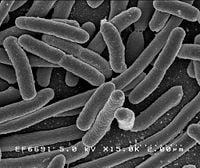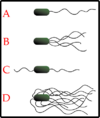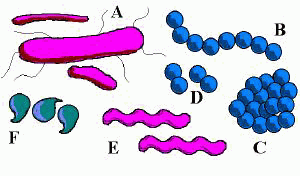Bacteria
| Bacteria | ||
|---|---|---|
 Escherichia coli | ||
| Scientific classification | ||
| ||
| Subgroups | ||
|
Actinobacteria |
- This article is about the single celled prokaryotes, for the stick insect genus, see Bacteria (genus)
Bacteria (singular: bacterium) are a major group of living organisms. The term "bacteria" has variously applied to all prokaryotes or to a major group of them, otherwise called the eubacteria, depending on ideas about their relationships. Here, bacteria is used specifically to refer to the eubacteria. Another major group of bacteria (used in the broadest, non-taxonomic sense) are the Archaea. The study of bacteria is known as bacteriology, a subfield of microbiology.
Bacteria are the most abundant of all organisms. They are ubiquitous in soil, water, and as symbionts of other organisms. Many pathogens, disease-causing organisms, are bacteria. Most are minute, usually only 0.5-5.0 μm in their longest dimension, although giant bacteria like Thiomargarita namibiensis and Epulopiscium fishelsoni may grow past 0.5 mm in size. They generally have cell walls, like plant and fungal cells, but with a very different composition (peptidoglycans). Many move around using flagella, which are different in structure from the flagella of other groups.
History
The first bacteria were observed by Anton van Leeuwenhoek in 1676 using a single-lens microscope of his own design. The name bacterium was introduced much later, by Ehrenberg in 1828, derived from the Greek word βακτηριον meaning "small stick". Because of the difficulty in describing individual bacteria and the importance of their discovery to fields such as medicine, biochemistry and geochemisty, the history of bacteria is generally described as the history of microbiology.
Cellular structure
Main article: Bacterial cell structure
As prokaryotes all bacteria have a relatively simple cell structure lacking a cell nucleus and organelles such as mitochondria and chloroplasts. Most bacteria are relatively small and possess distinctive cell and colony morphologies (shapes) as described below. The most important bacterial structural characteristic is the cell wall. Bacteria can be divided into two groups (Gram positive and Gram negative) based on differences in cell wall structure as revealed by Gram staining. Gram positive bacteria possess a cell wall containing a thick peptidoglycan (called Murein in older sources) layer and teichoic acids while Gram negative bacteria have an outer, lipopolysaccharide-containing membrane and a thin peptidoglycan layer located in the periplasm (the region between the outer and cytoplasmic membranes). Many bacteria contain other extracellular structures such as flagella, fimbriae and pili which are used for motility (movement), attachment and conjugation respectively. Some bacteria also contain capsules or slime layers that also facilitate bacterial attachment to surfaces and biofilm formation. Bacteria contain relatively few intracellular structures compared to eukaryotes but do contain a tightly supercoiled chromosome, ribosomes and several other species-specific structures such as intracellular membranes, nutrient storage structures, gas vesicles and magnetosomes. Some bacteria are capable of forming endospores which allows them to survive extreme environmental and chemical stresses. This property is restricted to specific Gram positive organisms such as Bacillus and Clostridium.
Reproduction
Bacteria reproduce through asexual reproduction (binary fission) which results in cell division. Two identical clone daughter cells are produced. Bacterial population growth is thus sometimes said to follow an approximate exponential growth phase.
Certain types of bacteria are also capable of sexual reproduction through bacterial conjugation. In conjugation, one bacterium transfers genetic material to another through a long, hollow tube called a sex pilus. The genetic material transferred may be either chromosomal or from a plasmid. Conjugation incresases the genetic variability of bacterial populations and facilitates the emergences of antibiotic resistance.
Movement
Motile bacteria can move about, either using flagella, bacterial gliding, or changes of buoyancy. A unique group of bacteria, the spirochaetes, have structures similar to flagella, called axial filaments, between two membranes in the periplasmic space. They have a distinctive helical body that twists about as it moves.
Bacterial flagella are arranged in many different ways. Bacteria can have a single polar flagellum at one end of a cell, clusters of many flagella at one end or flagella scattered all over the cell, as with Peritrichous. Many bacteria (such as E.coli) have two distinct modes of movement: forward movement (swimming) and tumbling. The tumbling allows them to reorient and introduces an important element of randomness in their forward movement. (see external links below for link to videos).
Motile bacteria are attracted or repelled by certain stimuli, behaviors called taxes - for instance, chemotaxis, phototaxis, mechanotaxis and magnetotaxis. In one peculiar group, the myxobacteria, individual bacteria attract to form swarms and may differentiate to form fruiting bodies. The myxobacteria move only when on solid surfaces, unlike E. coli which is motile in liquid or solid media.
Groups and identification
Historically, bacteria as originally studied by botanists were classified in the same way as plants, that is, mainly by shape. Bacteria come in a variety of different cell morphologies (shapes), including bacillus (rod-shape), coccus (spherical), spirillum (helical) and vibrio (curved bacillus). However, because of their small size bacteria are relatively uniform in shape and therefore classification based on morphology was unsuccessful. The first formal classification scheme was developed following the development of the Gram stain by Hans Christian Gram which separates bacteria based on the structural characteristics of their cell walls. This scheme included:
- Gracilicutes - Gram negative staining bacteria with a second cell membrane
- Firmicutes - Gram positive staining bacteria with a thick peptidoglycan wall
- Mollicutes - Gram negative staining bacteria with no cell wall or second membrane
- Mendosicutes - atypically staining strains now known to belong to the Archaea
Further developments (essentially) based on this scheme included comparisons of bacteria based on differences in cellular metabolism as determined by a wide variety of specific tests. Bacteria were also classified based on differences in cellular chemical compounds such as fatty acids, pigments and quinones for example. While these schemes allowed for the differentiation between bacterial strains, it was unclear whether these differences represented variation between distinct species or between strains of the same species. It was not until the utilization of genome-based techniques such as %guanine+cytosine ratio determination, genome-genome hybridization and gene sequencing (in particular the rRNA gene) that microbial taxonomy developed (or at least is developing) into a stable, accurate classification system. It should be noted, however, that due to the existence numerous historical classification schemes and our current poor understanding of microbial diversity, bacterial taxonomy remains a changing and expanding field.
Benefits and dangers
Bacteria are both harmful and useful to the environment, and animals, including humans. The role of bacteria in disease and infection is important. Some bacteria act as pathogens and cause tetanus, typhoid fever, pneumonia, syphilis, cholera, foodborne illness, leprosy, and tuberculosis(TB). Sepsis, a systemic infectious syndrome characterized by shock and massive vasodilation, or localized infection, can be caused by bacteria such as Streptococcus, Staphylococcus, or many gram-negative bacteria. Some bacterial infections can spread throughout the host's body and become systemic. In plants, bacteria cause leaf spot, fireblight, and wilts. The mode of infection includes contact, air, food, water, and insect-borne microorganisms. The hosts infected with the pathogens may be treated with antibiotics, which can be classified as bacteriocidal and bacteriostatic, which at concentrations that can be reached in bodily fluids either kill bacteria or hamper their growth, respectively. Antiseptic measures may be taken to prevent infection by bacteria, for example, prior to cutting the skin during surgery or swabbing skin with alcohol when piercing the skin with the needle of a syringe. Sterilization of surgical and dental instruments is done to make them sterile or pathogen-free to prevent contamination and infection by bacteria. Sanitizers and disinfectants are used to kill bacteria or other pathogens to prevent contamination and risk of infection.
In soil, microorganisms which reside in the rhizosphere (a zone that includes the root surface and the soil that adheres to the root after gentle shaking) help in the transformation of molecular dinitrogen gas as their source of nitrogen, converting it to nitrogenous compounds in a process known as nitrogen fixation. This serves to provide an easily absorbable form of nitrogen for many plants, which cannot fix nitrogen themselves. Many other bacteria are found as symbionts in humans and other organisms. For example, the presence of the gut flora in the large intestine can help prevent the growth of potentially harmful microbes.
The ability of bacteria to degrade a variety of organic compounds is remarkable. Highly specialized groups of microorganisms play important roles in the mineralization of specific classes of organic compounds. For example, the decomposition of cellulose, which is one of the most abundant constituents of plant tissues, is mainly brought about by aerobic bacteria that belong to the genus Cytophaga. This ability has also been utilized by humans in industry, waste processing, and bioremediation. Bacteria capable of digesting the hydrocarbons in petroleum are often used to clean up oil spills. Some beaches in Prince William Sound were fertilized in an attempt to facilitate the growth of such bacteria after the infamous 1989 Exxon Valdez oil spill. These efforts were effective on beaches that were not too thickly covered in oil.
Bacteria, often in combination with yeasts and molds, are used in the preparation of fermented foods such as cheese, pickles, soy sauce, sauerkraut, vinegar, wine, and yogurt. Using biotechnology techniques, bacteria can be bioengineered for the production of therapeutic drugs, such as insulin, or for the bioremediation of toxic wastes.
Miscellaneous
Two organelles, mitochondria and chloroplasts, are generally believed to have been derived from endosymbiotic bacteria.
Microorganisms are widely distributed and are most abundant where they have food, moisture, and the right temperature for their multiplication and growth. They can be carried by air currents from one place to another. The human body is home to billions of microorganisms; they can be found on skin surfaces, in the intestinal tract, in the mouth, nose, and other body openings. They are in the air one breathes, the water one drinks, and the food one eats.
The great antiquity of the bacteria has enabled them to evolve a great deal of genetic diversity. They are far more diverse than, say, the mammals or insects. For instance, the genetic distance between E. coli and Thermus aquaticus is greater than the distance between humans and oak trees.
Bacteria have the ability to perceive the concentration gradient of stimuli to a resolution of one part per 10k (equivalent to a human being able to discern between two coin-filled jars, one filled with 9,999, the other with 10,000).
See also
- Bacterial growth
- Bacteriocin
- Magnetotactic bacteria
- Microorganism
- Nanobacterium
- Transgenic bacteria
Sources
- Some text in this entry was merged with the Nupedia article entitled Bacteria, written by Nagina Parmar; reviewed and approved by the Biology group (editor: Gaytha Langlois, lead reviewer: Gaytha Langlois, lead copyeditors: Ruth Ifcher and Jan Hogle)
- This article contains material from the Science Primer published by the NCBI, which, as a US government publication, is in the public domain at http://www.ncbi.nlm.nih.gov/About/disclaimer.html.
Further reading
- Alcamo, I. Edward. Fundamentals of Microbiology. 5th ed. Menlo Park, California: Benjamin Cumming, 1997.
- Atlas, Ronald M. Principles of Microbiology. St. Louis, Missouri: Mosby, 1995.
- Holt, John.G. Bergey's Manual of Determinative Bacteriology. 9th ed. Baltimore, Maryland: Williams and Wilkins, 1994.
- Hugenholtz P, Goebel BM, Pace NR (1998). "Impact of culture-independent studies on the emerging phylogenetic view of bacterial diversity". J Bacteriol 180 (18): 4765-74. PMID 9733676.
- Koshland, Daniel E., Jr. (1977). "A Response Regulator Model in a Simple Sensory System". Science 196: 1055-1063. PMID 870969.
- Stanier, R.Y., J. L. Ingraham, M. L. Wheelis, and P. R. Painter. General Microbiology. 5th ed. Upper Saddle River, New Jersey: Prentice Hall, 1986.
External links
- Bacterial Nomenclature Up-To-Date from DSMZ
- Bacterial Growth and Cell Wall (Ger)
- Microminds
- The largest bacteria
- Tree of Life
- Videos of bacteria swimming and tumbling, use of optical tweezers and other fine videos.
- Planet of the Bacteria by Stephen Jay Gould
- Major Groups of Prokaryotes
Credits
New World Encyclopedia writers and editors rewrote and completed the Wikipedia article in accordance with New World Encyclopedia standards. This article abides by terms of the Creative Commons CC-by-sa 3.0 License (CC-by-sa), which may be used and disseminated with proper attribution. Credit is due under the terms of this license that can reference both the New World Encyclopedia contributors and the selfless volunteer contributors of the Wikimedia Foundation. To cite this article click here for a list of acceptable citing formats.The history of earlier contributions by wikipedians is accessible to researchers here:
The history of this article since it was imported to New World Encyclopedia:
Note: Some restrictions may apply to use of individual images which are separately licensed.

